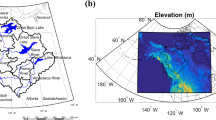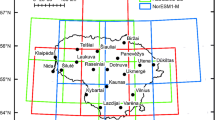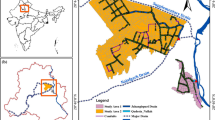Abstract
Understanding climate change impacts on winter road systems in Ontario’s Far North is critical due to the high dependence on such seasonal corridors by local residences, particularly among remote First Nations communities. In recent years, a warmer climate has resulted in a shorter winter road season and an increase in unreliable road conditions, thus limiting access among remote communities. This study focused on examining the future freezing degree day (FDD) accumulations during the preconditioning period of the winter roads at five locations using the multi-model ensembles of general circulation models (GCMs) and regional climate models (RCMs), under the representative concentration pathway (RCP) scenarios. The Statistical DownScaling Model Decision Centric Version 5 (SDSM-DC) was applied to validate the baseline climate. The results from the CMIP5 showed that by mid-century, the trends of FDDs under RCP4.5 for Moosonee and Kapuskasing were projected to decrease below the lowest threshold with the mean FDDs at 376 and 363, respectively. Under RCP8.5, the mean FDDs for Lansdowne House and Red Lake were projected to be below the lowest threshold, at 356 and 305, respectively, by the end of the century. Results of the FDD threshold measure indicated that climate conditions would possibly be unfavorable during the winter road construction period by mid-century for Moosonee and Kapuskasing and for Lansdowne House and Red Lake by the end of the century. For Big Trout Lake, on the other hand, climate conditions are expected to remain favorable for the winter road construction through the end of 2100.



Similar content being viewed by others
References
Adam KM (1978) Building and operating winter roads in Canada and Alaska. Minister of Indian and Northern Affairs, Ottawa
Aguado E, Burt JE (2007) Understanding weather and climate, 4th edn. Pearson Education Inc., New Jersey
ACIA (2005) Arctic climate impact assessment. Cambridge University Press, Cambridge
Assel RA (1980) Maximum freezing degree-days as a winter severity index for the Great Lakes, 1897–1977. Mon Weather Rev 108:1440–1445
Blair D, Sauchyn D (2010) Winter roads in Manitoba. In: Sauchyn D, Diaz H, Kulshreshtha S (eds) The new normal: the Canadian prairies in a changing climate. CPRC Press, Regina, pp 322–325
Bonsal BR, Prowse TD, Duguay CR, Lacroix MP (2006) Impacts of large-scale teleconnections on freshwater-ice break/freeze-up dates over Canada. J Hydrol 330:340–353
Carpenter L (2015) Moose Cree completes winter road. http://www.wawataynews.ca/home/moose-cree-completes-winter-road. Accessed 1 July 2017
CCDS (2015) CMIP5 (AR5). http://ccds-dsccecgcca/ Accessed 1 December 2015
CIER (2006) Climate change impacts on ice, winter roads, access trails, and Manitoba First Nations. http://www.nrcan.gc.ca/earth-sciences/projdb/pdf/187b_e.pdf. Accessed 16 April 2012
Chiotti Q, Lavender B (2008) Ontario. In: Lemmen DS, Warren FJ, Lacroix J, Bush E (eds) From impacts to adaptation: Canada in a changing climate 2007. Government of Canada, Ottawa, pp 227–274
Diaz-Nieto J, Wilby RL (2005) A comparison of statistical downscaling and climate change factor methods: impacts on low flows in the river Thames, United Kingdom. Clim Chang 69:245–268
Environment Canada (2015) Canadian climate data. http://climate.weather.gc.ca/. Accessed 1 November 2015
Far North Science Advisory Panel (2010) Science for a changing Far North. The report of the Far North science advisory panel. Ontario Ministry of Natural Resources, Ontario
Flato G, Marotzke J, Abiodun B et al (2013) Evaluation of climate models. In: Stocker TF et al (eds) Climate change 2013: the physical science basis. Contribution of working group I to the fifth assessment report of the Intergovernmental Panel on Climate Change. Cambridge University Press, Cambridge, pp 741–866
Furgal C, Prowse T (2008) Northern Canada. In: Lemmen DS, Warren FJ, Lacroix J, Bush E (eds) From impacts to adaptation: Canada in a changing climate. Government of Canada, Ottawa, pp 57–118
Gagnon AS, Gough WA (2005) Trends in the dates of ice freeze-up and breakup over Hudson Bay, Canada. Arctic 58:370–382
Gough WA, Cornwell AR, Tsuji LJS (2004) Trends in seasonal sea ice duration in southwestern Hudson Bay. Arctic 57:299–305
Government of Ontario (2015a) Far North Act, 2010, S.O. 2010, c. 18. http://www.ontario.ca/laws/statute/10f18. Accessed 7 December 2015
Government of Ontario (2015b) Northern Ontario winter roads. http://www.mndm.gov.on.ca/en/northern-development/transportation-support/northern-ontario-winter-roads. Accessed 1 December 2015
Helsel DR, Hirsch RM (2002) Statistical methods in water resources. Elsevier, Amsterdam
Hori Y, Gough WA, Butler K, Tsuji LJS (2016) Trends in the seasonal length and opening dates of a winter road in the western James Bay region, Ontario, Canada. Theor Appl Climatol. https://doi.org/10.1007/s00704-016-1855-1
Kalnay et al (1996) The NCEP/NCAR 40-year reanalysis project. Bull Amer Meteor Soc 77:437–471
Knowland KE, Gyakum JR, Lin CA (2010) A study of the meteorological conditions associated with anomalously early and late openings of a northwest territories winter road. Arctic 63:227–239
Kowal S, Gough WA, Butler K (2015) Temporal evolution of Hudson Bay sea ice (1971–2011). Theor Appl Climatol. https://doi.org/10.1007/s00704-015-1666-9
Larsen JN, Anisimov OA, Constable A et al (2014) Polar regions. In: Barros VR et al (eds) Climate change 2014: impacts, adaptation, and vulnerability. Part B: regional aspects. Contribution of working group II to the fifth assessment report of the intergovernmental panel on climate change. Cambridge University Press, Cambridge, pp 1567–1612
Lonergan S, Difrancesco R, Woo M-K (1993) Climate change and transportation in northern Canada: an integrated impact assessment. Clim Chang 24:331–351
Moss RH, Edmonds J, Hibbard K et al (2010) The next generation of scenarios for climate change research and assessment. Nature 463:747–756
Mullan D, Swindles G, Patterson T et al (2016) Climate change and the long-term viability of the world’s busiest heavy haul ice road. Theor Appl Climatol. https://doi.org/10.1007/s00704-016-1830-x
O’Sullivan J, Sweeney C, Nolan P, Gleeson P (2015) A high-resolution, multi-model analysis of Irish temperatures for the mid-21st century. Int J Climatol. https://doi.org/10.1002/joc.4419
Sen PK (1968) Estimates of the regression coefficient based on Kendall’s tau. J Am Stat Assoc 63:1379–1389
Stephenson SR, Smith LC, Agnew JA (2011) Divergent long-term trajectories of human access to the Arctic. Nature Clim Change 1:156–160
Tam A, Gough WA, Kowal S, Xie C (2014) The fate of Hudson Bay lowlands palsas in a changing climate. Arct Antarct Alp Res 46:114–120
Tam BY, Gough WA, Edwards V, Tsuji LJS (2013) The impact of climate change on the lifestyle and well-being of a first nation community in the western James Bay region. Can Geogr 57:441–456
Taylor KE, Stouffer RJ, Meehl GA (2012) An overview of CMIP5 and the experiment design. B Am Meteorol Soc 93:485–498
van Vuuren DP, Stehfest E, den Elzen MGJ et al (2011) RCP2.6: exploring the possibility to keep global mean temperature increase below 2°C. Clim Chang 109:95–116
Vincent LA, Wang XL, Milewska EJ, Wan H, Yang F, Swail V (2012) A second generation of homogenized Canadian monthly surface air temperature for climate trend analysis. J Geophys Res 117:D18110
Wawatay News (2005) Mild winter delays winter road openings. http://www.wawataynews.ca. Accessed 1 January 2014
Wilby RL, Dawson CW, Murphy C et al (2014) The statistical DownScaling model–decision centric (SDSM-DC): conceptual basis and applications. Clim Res 61:259–276
Wilby RL, Hay LE, Leavesley GH (1999) A comparison of downscaled and raw GCM output: implications for climate change scenarios in the San Juan River basin, Colorado. J Hydrol 225:67–91
Acknowledgements
This research was supported by Ontario’s Ministry of the Environment and Climate Change.
Author information
Authors and Affiliations
Corresponding author
Electronic supplementary material
ESM 1
(DOCX 679 kb)
Rights and permissions
About this article
Cite this article
Hori, Y., Cheng, V.Y.S., Gough, W.A. et al. Implications of projected climate change on winter road systems in Ontario’s Far North, Canada. Climatic Change 148, 109–122 (2018). https://doi.org/10.1007/s10584-018-2178-2
Received:
Accepted:
Published:
Issue Date:
DOI: https://doi.org/10.1007/s10584-018-2178-2




